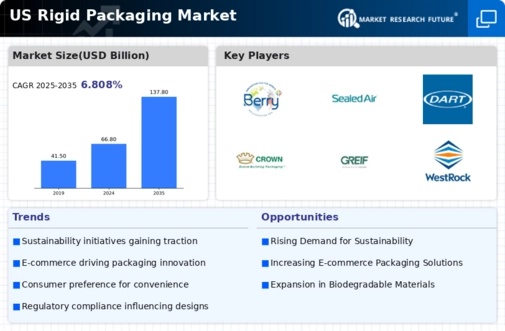Consumer Preference for Convenience
The rigid plastic-packaging market is witnessing a shift in consumer preferences towards convenience-oriented packaging solutions. As lifestyles become increasingly fast-paced, consumers favor packaging that is easy to use, resealable, and portable. Rigid plastic packaging meets these demands by offering features such as easy-open designs and lightweight materials. In the US, approximately 60% of consumers express a preference for packaging that enhances convenience, indicating a strong market potential for products that align with this trend. Manufacturers are responding by developing innovative packaging solutions that cater to these preferences, thereby driving growth in the rigid plastic-packaging market. This focus on convenience not only enhances consumer satisfaction but also encourages repeat purchases.
Rise in E-commerce and Online Retail
The rigid plastic-packaging market is significantly influenced by the rapid growth of e-commerce and online retail. As more consumers turn to online shopping, the demand for robust and secure packaging solutions has surged. Rigid plastic packaging offers excellent protection for products during transit, reducing the risk of damage and returns. In the US, e-commerce sales are expected to reach $1 trillion by 2025, driving the need for efficient packaging solutions. This trend compels manufacturers to innovate and provide packaging that not only safeguards products but also enhances the unboxing experience for consumers. Consequently, the rigid plastic-packaging market is likely to see increased investments in packaging design and functionality to cater to the evolving needs of online retailers.
Growing Demand for Lightweight Packaging
The rigid plastic-packaging market is experiencing a notable shift towards lightweight packaging solutions. This trend is driven by the need for cost-effective and efficient packaging that reduces transportation costs and environmental impact. Lightweight materials not only lower shipping expenses but also contribute to sustainability goals by minimizing material usage. In the US, the demand for lightweight rigid plastic packaging is projected to increase by approximately 15% over the next five years. Companies are increasingly adopting these solutions to enhance their product offerings while meeting consumer preferences for eco-friendly options. As a result, manufacturers in the rigid plastic-packaging market are investing in research and development to create innovative lightweight materials that maintain durability and functionality.
Increased Focus on Food Safety and Preservation
The rigid plastic-packaging market is significantly impacted by the heightened emphasis on food safety and preservation. As consumers become more health-conscious, the demand for packaging that ensures product integrity and extends shelf life is on the rise. Rigid plastic packaging provides excellent barrier properties, protecting food products from contamination and spoilage. In the US, the food packaging segment is projected to account for over 40% of the rigid plastic-packaging market by 2026. This trend compels manufacturers to invest in advanced packaging technologies that enhance food safety while complying with stringent regulations. As a result, the rigid plastic-packaging market is likely to see innovations aimed at improving preservation techniques and ensuring consumer trust in food products.
Technological Innovations in Manufacturing Processes
The rigid plastic-packaging market is benefiting from ongoing technological innovations in manufacturing processes. Advances in production techniques, such as injection molding and blow molding, are enabling manufacturers to create more complex and efficient packaging designs. These innovations not only enhance the aesthetic appeal of packaging but also improve functionality and reduce production costs. In the US, the adoption of automation and smart manufacturing technologies is expected to increase productivity in the rigid plastic-packaging market by approximately 20% over the next few years. This shift towards more efficient manufacturing processes allows companies to respond quickly to market demands while maintaining high-quality standards. Consequently, the rigid plastic-packaging market is poised for growth as manufacturers leverage these technological advancements.






















Leave a Comment